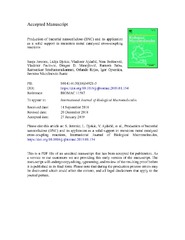Приказ основних података о документу
Production of bacterial nanocellulose (BNC) and its application as a solid support in transition metal catalysed cross-coupling reactions
| dc.creator | Jeremić, Sanja | |
| dc.creator | Đokić, Lidija | |
| dc.creator | Ajdačić, Vladimir | |
| dc.creator | Božinović, Nina S. | |
| dc.creator | Pavlović, Vladimir D. | |
| dc.creator | Manojlović, Dragan D. | |
| dc.creator | Babu, Ramesh P. | |
| dc.creator | Senthamaraikannan, Ramsankar | |
| dc.creator | Rojas, Orlando | |
| dc.creator | Opsenica, Igor | |
| dc.creator | Nikodinović-Runić, Jasmina | |
| dc.date.accessioned | 2019-04-05T15:25:52Z | |
| dc.date.available | 2020-01-27 | |
| dc.date.issued | 2019 | |
| dc.identifier.issn | 0141-8130 | |
| dc.identifier.uri | https://cherry.chem.bg.ac.rs/handle/123456789/2866 | |
| dc.description.abstract | Bacterial nanocellulose (BNC) emerged as an attractive advanced biomaterial that provides desirable properties such as high strength, lightweight, tailorable surface chemistry, hydrophilicity, and biodegradability. BNC was successfully obtained from a wide range of carbon sources including sugars derived from grass biomass using Komagataeibacter medellinensis ID13488 strain with yields up to 6 g L −1 in static fermentation. Produced BNC was utilized in straightforward catalyst preparation as a solid support for two different transition metals, palladium and copper with metal loading of 20 and 3 wt%, respectively. Sustainable catalysts were applied in the synthesis of valuable fine chemicals, such as biphenyl-4-amine and 4′-fluorobiphenyl-4-amine, used in drug discovery, perfumes and dye industries with excellent product yields of up to 99%. Pd/BNC catalyst was reused 4 times and applied in two consecutive reactions, Suzuki-Miyaura cross-coupling reaction followed by hydrogenation of nitro to amino group while Cu/BNC catalyst was examined in Chan-Lam coupling reaction. Overall, the environmentally benign process of obtaining nanocellulose from biomass, followed by its utilisation as a solid support in metal-catalysed reactions and its recovery has been described. These findings reveal that BNC is a good support material, and it can be used as a support for different catalytic systems. | |
| dc.publisher | Elsevier | |
| dc.relation | info:eu-repo/grantAgreement/MESTD/Basic Research (BR or ON)/172008/RS// | |
| dc.relation | info:eu-repo/grantAgreement/MESTD/Basic Research (BR or ON)/173048/RS// | |
| dc.rights | embargoedAccess | |
| dc.rights.uri | https://creativecommons.org/licenses/by-nc-nd/4.0/ | |
| dc.source | International Journal of Biological Macromolecules | |
| dc.subject | Bacterial nanocellulose | |
| dc.subject | Cross-coupling reactions, catalysis | |
| dc.subject | Komagataeibacter medellinensis | |
| dc.title | Production of bacterial nanocellulose (BNC) and its application as a solid support in transition metal catalysed cross-coupling reactions | |
| dc.type | article | |
| dc.rights.license | BY-NC-ND | |
| dcterms.abstract | Бабу, Рамесх П.; Сентхамараиканнан, Рамсанкар; Aјдачић, Владимир; Божиновић, Нина С.; Никодиновић-Рунић, Јасмина; Павловић, Владимир Д.; Манојловић, Драган Д.; Ројас, Орландо; Опсеница, Игор; Јеремић, Сања; Ђокић, Лидија; | |
| dc.citation.volume | 129 | |
| dc.citation.spage | 351 | |
| dc.citation.epage | 360 | |
| dc.identifier.wos | 000466621200037 | |
| dc.identifier.doi | 10.1016/j.ijbiomac.2019.01.154 | |
| dc.citation.rank | aM21~ | |
| dc.description.other | This is the peer-reviewed version of the following article: Jeremic, S.; Djokic, L.; Ajdačić, V.; Božinović, N.; Pavlovic, V.; Manojlović, D. D.; Babu, R.; Senthamaraikannan, R.; Rojas, O.; Opsenica, I.; et al. Production of Bacterial Nanocellulose (BNC) and Its Application as a Solid Support in Transition Metal Catalysed Cross-Coupling Reactions. Int. J. Biol. Macromol. 2019, 129, 351–360. [https://doi.org/10.1016/j.ijbiomac.2019.01.154] | |
| dc.type.version | acceptedVersion | |
| dc.identifier.scopus | 2-s2.0-85061444472 | |
| dc.identifier.fulltext | https://cherry.chem.bg.ac.rs/bitstream/id/6625/10.1016@j.ijbiomac.2019.01.154.pdf |


